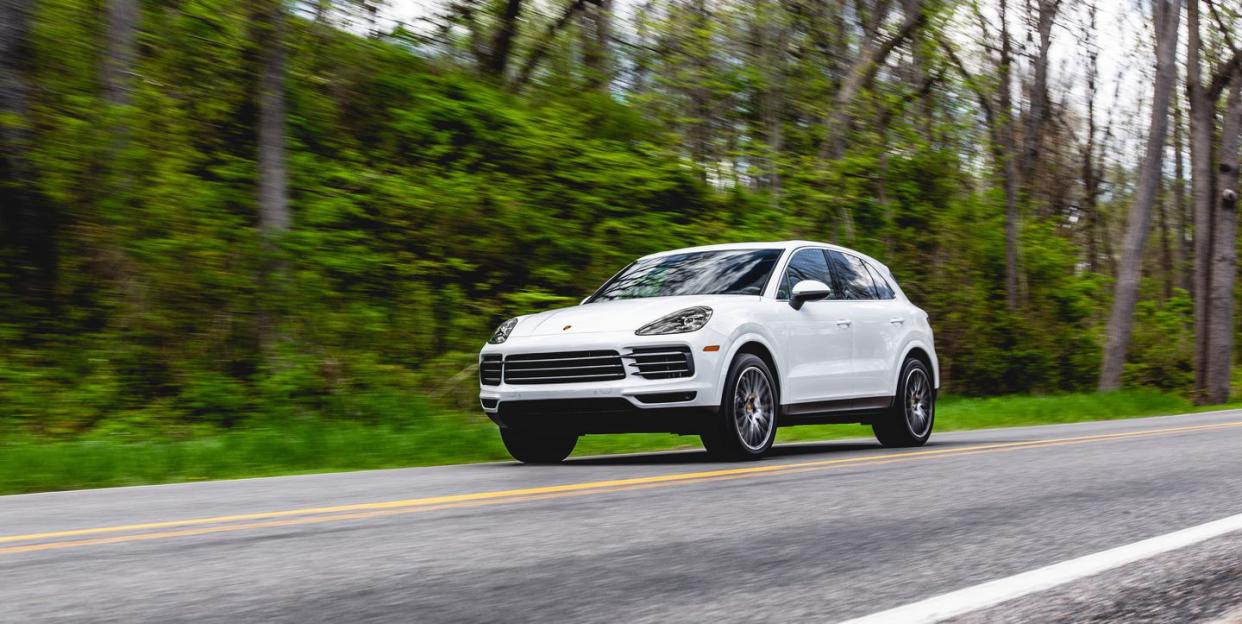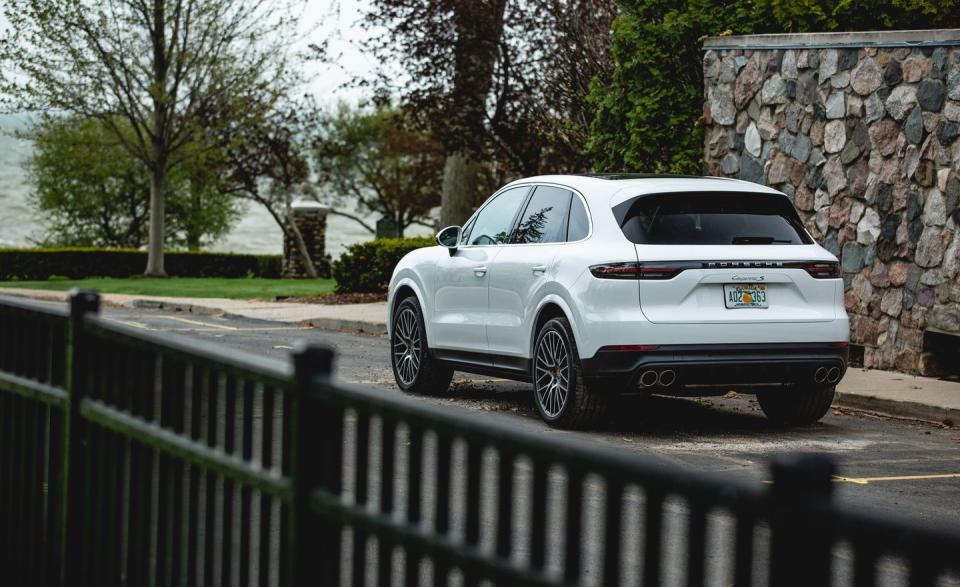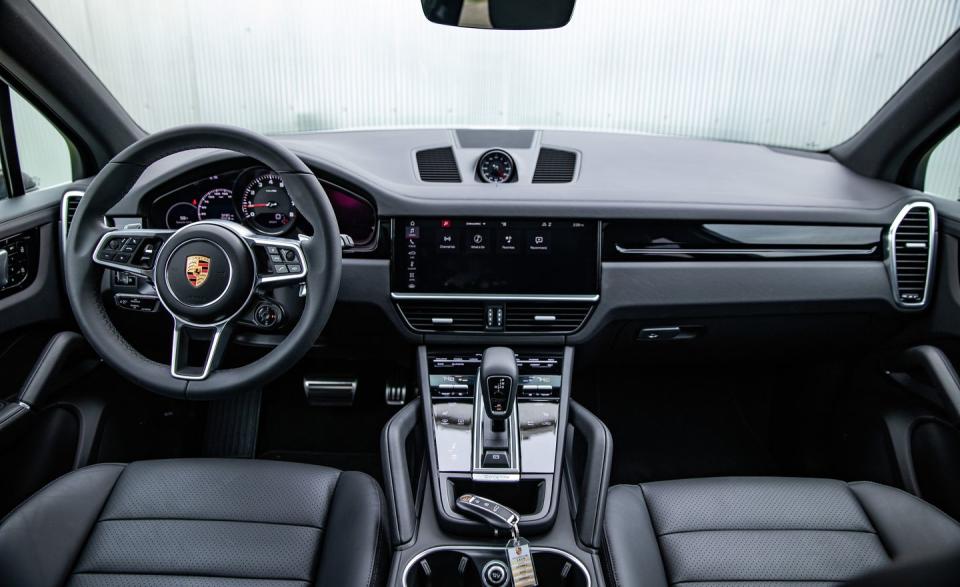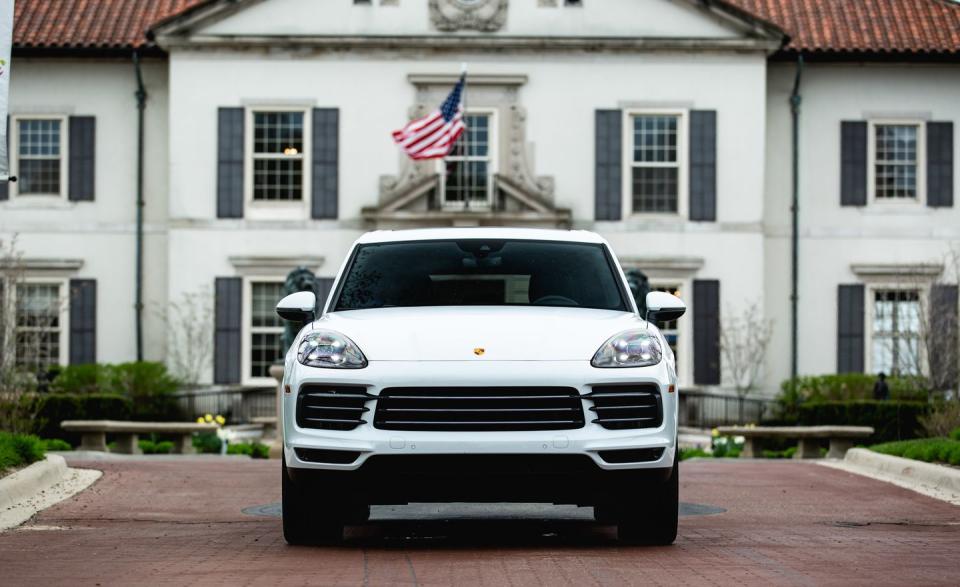The 2019 Porsche Cayenne S Is a Sports Sedan on Stilts

The line separating cars and SUVs grows blurrier every day. Whether you try to split today's auto market by ground clearance, roof height, body-on-frame vs. unibody construction, or the distinction between driveline components, there's always an exception to the rule. Even deferring to subjective judgment—"I know an SUV when I see one"—isn't foolproof. While its proportions are unmistakable as an SUV's, the 2019 Porsche Cayenne S accelerates, brakes, and turns as if it is a sports sedan.
The 434-hp Cayenne S bolts to 60 mph in 4.2 seconds. Its twin-turbocharged 2.9-liter V-6 crashes the quarter-mile in 12.8 seconds at 109 mph. On the optional 21-inch Pirelli P Zero summer tires, the Porsche latches to the pavement with 0.93 g of cornering grip. Stand on the left pedal, and the S channels that stick into a 152-foot stop from 70 mph. Those figures place the Cayenne S in the same performance class as middle-rung sports four-doors such as the Mercedes-AMG C43 sedan and the Audi S5 Sportback. Those cars are lighter and lower than the Cayenne S, but line up this group at a drag strip or a road course, and any race you dream up would be too close to predict.

Feelin' Fine
Of course, Porsche is hardly the only automaker to conjure carlike performance from a modern utility vehicle. BMW M and Mercedes-AMG utes are equally capable of chest-compressing acceleration, neck-straining deceleration, and gut-churning lateral grip. But while other automakers can replicate the Cayenne's performance, none comes close to imitating the experience. There's something special in the control feel, the chassis responses, and the way the driver connects with the Cayenne S.
Porsche delivers steering that's far better than a vehicle this tall, large, and heavy deserves. Alert on center and naturally weighted throughout its full range of motion, the steering responds to inputs predictably and with the utmost precision. Cinched-down body control makes for unflappable cornering behavior regardless of whether the road is smooth or lumpy. We find comfort in that control, with the Cayenne's suspension dismissing events in a single stroke. We also acknowledge that the Porsche SUV isn't for everyone. The Cayenne S is rarely harsh, but its short, quick, and firm suspension may be too much for drivers looking to tiptoe over America's buckled and broken roads. Those who fondly remember American cars of the 1960s should seek out something with a softer, more isolating ride.

At 4802 pounds, the Cayenne S is hardly svelte, but it does weigh roughly 200 pounds less than its next-lightest competitors. This weight advantage helps in every aspect of performance, allowing the engine, brakes, and tires to make the most of what they’ve got. In the case of the twin-turbo V-6, the effortless shove of 405 lb-ft of torque covers the majority of the rev range, from 1800 to 5500 rpm. The quick-witted eight-speed automatic transmission makes sure that torque-rich punch is never more than a single downshift and a fraction of a second from slugging your backside. The engine, also used in the Porsche Panamera 4S and the Audi RS5, is energetic when you want it to be and genteel when you back off the accelerator. It's well suited to the Cayenne, a vehicle that will be driven in parking lots and 25-mph neighborhoods more than meandering county back roads yet also wears the Porsche crest on its hood.
The Cayenne's dynamic excellence is that much more impressive because the third-generation model shares more parts than ever with its Volkswagen Group cousins and even its competitors. It rides on the MLB Evo platform that also underpins the Audi Q7, the Bentley Bentayga, the Lamborghini Urus, and a bevy of mid-size and large cars. The Audi-developed 2.9-liter V-6 delivers its torque to the ZF 8HP eight-speed automatic transmission that's used in everything from the Dodge Charger to the Aston Martin Vantage. That pedigree sounds like it could be cobbled together by any engineering student, and yet the Cayenne S evinces the practiced craft of truly masterful engineering. Its greatest virtues are buried deep in the software, the bushings, and the damping rates.

Only in a Porsche
You'll pay for that world-class tuning. Starting at $84,150, the Cayenne S carries the usual Porsche pricing premium that makes it more expensive than its closest peer. In this case, that's $15,005 more than the 2019 Mercedes-AMG GLC43. The Cayenne S also comes equipped with only the bare minimum of standard equipment. Passive entry, heated seats, and driver-assist systems such as adaptive cruise control, blind-spot monitoring, and lane-keeping assistance are just a few of the many extra-cost add-ons. Our test car added nearly $15K to the sticker with only eight options and still managed to feel relatively spartan. Those options included the leather interior ($3750), the 21-inch wheels ($3830), a Bose stereo ($1200), and the Sport Chrono package ($1130), which adds a Sport Plus driving mode, a Sport stability-control setting, and launch-control features. The window sticker also listed $400 for ambient lighting, $530 for heated front seats, and $490 for auto-dimming mirrors.
Finally, our Cayenne S wore the new Porsche Surface Coated Brakes, a $3490 extra. Also known as PSCB, this option adds larger front and rear iron brake rotors plated with a razor-thin layer of tungsten carbide, a compound that is nearly as hard as diamond, as well as sizable 10-piston front calipers. The coating reduces the amount of brake dust that accumulates on the wheels. It also gives the discs a mirror-like finish that simply looks cool and increases brake life by a claimed 30 percent. However, many of our drivers complained that the Surface Coated Brakes are touchy and difficult to modulate when negotiating city streets. It is also worth noting that the 16.3-inch front rotors necessitate upgrading from the standard 19-inch wheel to at least a 20-incher, the most affordable of which runs $1720.

Porsche's latest interior scheme, first seen on the second-generation Panamera, trades the homely but functional array of buttons for large, unbroken swaths of glossy black plastic with touch-sensitive icons glowing through. It also bundles and buries deep into the 12.3-inch touchscreen many of the controls that were always at hand in the old model. That screen is attractive, but it's also an excellent example of the difference between styling and design. Porsche's arrangement is easier to use than systems that rely on a laptop-esque touchpad, such as those found in the newest Mercedes-Benz and Lexus models. Still, it's nowhere near as intuitive as the rotary controller still favored by BMW.
While it's a stylish and luxurious thing, the Porsche Cayenne S greatest virtue is its remarkable performance and unique driving qualities—both those implied by the badge on the hood and those verified by our testing. Even as the market for hot-rod SUVs grows with new entries, the Porsche Cayenne holds its place as a sporty four-door that also happens to be an SUV.

('You Might Also Like',)

